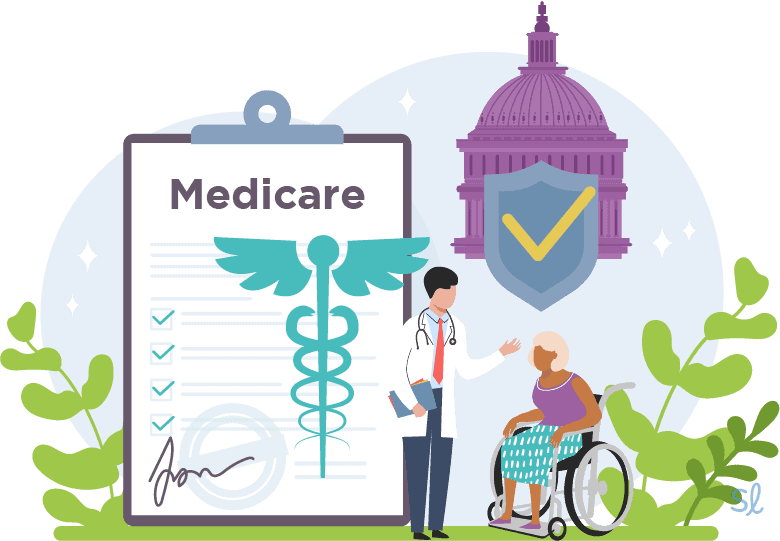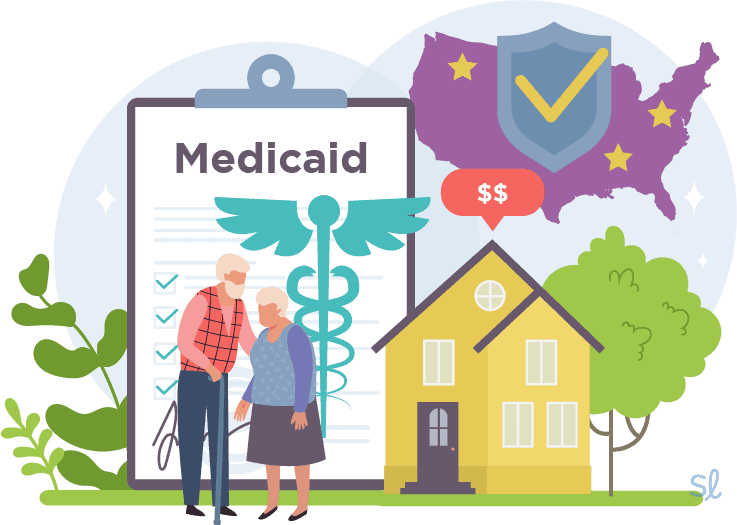Medicare and Medicaid Health Insurance
Medicare is a federal health insurance program, while Medicaid is a joint federal and state health insurance program designed for low-income Americans.
SeniorLiving.org is supported by commissions from providers listed on our site. Read our Editorial Guidelines
Since 1965, Medicare and Medicaid have been protecting the health and well-being of millions of Americans. Though these government programs have evolved over the years, they still provide beneficiaries like seniors, people with disabilities, and low-income families access to affordable, quality health care.
Familiarizing yourself with Medicare and Medicaid can help you determine if you’re eligible and how these government programs can assist you in living a longer, more independent life. Here, we’ll cover all the basics of Medicare and Medicaid, their differences, and how to know if you qualify for either (or both).
Did You Know? Medicare Annual Enrollment runs from Oct. 15 to Dec. 7. It’s important to review your plan during enrollment each year, as benefits can change. Visit our Medicare Advantage ZIP code search tool to compare options in your area and ensure you have the right plan for your needs.
What Is the Difference Between Medicare and Medicaid?
With similar-sounding names, it’s no wonder that Medicare and Medicaid get confused sometimes! Both are funded by taxpayers; what sets these two programs apart is who they provide health care coverage for.
Original Medicare is a federal health insurance program that provides health care coverage for Americans age 65 and older, as well as those who live with a disability.
Medicaid is a joint federal and state health insurance program that covers Americans with a limited income. Adults who are 65 or older and meet the limited-income requirements may be covered by both programs.
Our free housing and care finder uses your unique needs to curate a list of the best options in your area.
What Is Medicare?
Medicare subsidizes health care costs for Americans 65 and older, and some people under 65 with certain disabilities or conditions. It’s the primary form of health insurance for seniors. While Medicare certainly helps reduce medical expenses, it doesn’t cover everything. Let’s look at the plans and benefits that make up Medicare.
Original Medicare consists of two parts:
- Medicare Part A (Hospital Insurance)
- Medicare Part B (Medical Insurance)
As mentioned earlier, Original Medicare covers some health care costs, but not all of them. For example, there’s no yearly limit on what you pay out of pocket with Original Medicare.
The good news is that enrollees have additional options that may reduce out-of-pocket expenses. These programs allow individuals to add additional benefits through private insurance companies that contract with Medicare:
- Medicare Part C (Medicare Advantage)
- Medicare Part D (Prescription Drug Plan)
- Medicare Supplement Insurance (Medigap)
We’ll go into more detail about the different parts of Medicare a little later on.
To learn more about Medicare, watch the video below with our Editor-in-Chief, Jeff Hoyt.

Who Qualifies for Medicare?
To qualify for Medicare coverage, you must be a United States resident and either a U.S. citizen or a lawfully admitted alien who has lived in the U.S. for five continuous years. You also must meet at least one of the following criteria:1
- You’re 65 or older
- You’ve been disabled for over 24 months
- You’ve been diagnosed with end-stage renal disease
- You have Lou Gehrig’s disease (ALS)
Medicare Enrollment Options
Every day, nearly 10,000 Americans age into the Medicare program.2 Despite the large number of people who qualify for Medicare, there are only certain times throughout the year when seniors and other eligible beneficiaries can enroll. We’ll touch on the six options for enrollment below. Once you’re enrolled in Medicare, you’ll receive your red, white, and blue Medicare card in the mail, as well as a welcome packet.
- Initial enrollment period: You have a seven-month window around your 65th birthday to enroll in Medicare. It begins three months before your birthday month and ends three months after your 65th birth month. It is best to enroll during this time to avoid being charged late enrollment penalties.
- Annual enrollment period: Medicare’s annual open enrollment is from Oct. 15 to Dec. 7. During this time, you may be able to join, drop, or switch to another plan. This includes Medicare Advantage (Medicare Part C) and Medicare Part D Prescription Drug Plans.
- General enrollment period: If you miss your seven-month window, you may be able to enroll during the general enrollment period, which is Jan. 1 to March 31 each year. If you enroll during this time, your coverage will begin July 1 of the same year. You may have to pay a higher Part A or Part B premium for missing the initial enrollment period.
- Special enrollment period: Individuals age 65 and older who are still in the workforce may be covered by their employer’s group health plan (or their spouse’s health plan). In this case, you can enroll anytime you’re still covered by the group health or during the eight-month period after your coverage ends. The special enrollment period is applicable to seniors who are 65 and working but thinking about retirement.
- Medicare Advantage open enrollment period: If you’re enrolled in a Medicare Advantage Plan, you can switch to a different Medicare Advantage Plan or switch to Original Medicare (and join a separate Medicare drug plan) once from Jan. 1 to March 31 each year.
- Medigap open enrollment period: Medigap’s six-month open enrollment begins on the first day of the month in which you are 65 or older and have enrolled in Medicare Part B.
Pro Tip: Getting ready to enroll in Medicare for the first time or make changes to your current plan? Our in-depth Medicare enrollment guide covers everything you need to know about Medicare.
How to Enroll in Medicare
If you’re currently receiving Social Security benefits, you’ll automatically be enrolled in Medicare. You should receive your Medicare card and welcome packet in the mail three months before your 65th birthday.
If you aren’t yet receiving Social Security benefits but would like to enroll in Medicare, you can do so by creating a my Social Security account and applying through the Social Security Administration (SSA) benefits page.
If you’d prefer to enroll by phone, you can call the SSA toll-free at 800-772-1213. If you have hearing loss, call the toll-free TTY number at 800-325-0778. Representatives are available from 7 a.m. to 7 p.m., Monday through Friday.
>> Further Reading: Medicare helplines
What You Don’t Know About Medicare That Could Hurt You
Medicare is a complicated program; however, once you’re equipped with the right information, you can enroll knowing you’re getting the most out of your Medicare plan. Before you enroll, watch the video below with Jeff Hoyt as he covers what you might not know about Medicare that could hurt you.

What Does Medicare Cover?
If you’re unsure why we have Medicare Part A and Part B or wondering what the difference is between Medigap and Medicare Advantage, we have the answers! Read on to find out the main purpose of each part of Medicare and what they cover.
Medicare Part A
Medicare Part A, sometimes referred to as “hospital insurance,” covers hospital and hospice expenses. This includes inpatient care, hospice care, home health care, and short-term stays in a skilled nursing facility.
Adults age 65 and over are eligible for premium-free Medicare Part A at no cost if:
- You’re already receiving retirement benefits from Social Security or the Railroad Retirement Board
- You’re eligible to receive Social Security or Railroad benefits but haven’t filed for them yet
- You or your spouse had Medicare-covered government employment
Hospital expenses covered by Medicare Part A3:
- Semiprivate rooms
- General nursing
- Meals
- Drugs needed during inpatient treatment
- Other hospital services and supplies as part of your inpatient treatment
Did You Know? Medicare Part A does not cover long-term care (also called custodial care), if that’s the only care you need.4
Medicare Part B
Anyone who is eligible for Medicare Part A is also eligible for Medicare Part B. Medicare Part B covers preventative and medically necessary services. You can expect to pay a monthly premium for Medicare Part B coverage. If you’re receiving Social Security, it will automatically be deducted from your check. If you’re not receiving benefits yet, you’ll get a bill for your Medicare Part B premium in the mail.
Preventative and medically necessary services covered by Medicare Part B5:
- Screenings
- Vaccinations
- Annual wellness visits
- Ambulance transportation
- Durable medical equipment (DME)
Medicare Advantage Plans (Medicare Part C)
Those who would like to pass on Original Medicare can opt for a Medicare Advantage Plan. These plans are sold by private companies that contract with Medicare to provide coverage. Medicare Advantage plans include Medicare Part A, Part B, and often, a Part D Prescription Drug Plan. A considerable number of Medicare Part C plans also offer dental, vision, drug, and hearing coverage.
The downside to Part C is that many plans require you to see doctors and use services in a certain network, so you may be limited in where you can receive health care services without paying more for going out of network. Medicare Advantage Plans vary by state, so check with your local carriers to determine what plans are available in your area.
Medicare Part D
As you research your Medicare options, keep in mind that Original Medicare doesn’t cover prescription medications. These out-of-pocket costs can derail your budget, especially if you’re living on a fixed income.
Medicare Part D is optional and provides coverage for prescription drugs. During your initial enrollment period, carefully consider a Medicare Part D plan (even if you don’t need prescriptions now). Late enrollment can result in a late enrollment penalty that you may have to pay for as long as you have Medicare drug coverage.
Pro Tip: SeniorLiving.org’s experts analyzed leading Medicare Part D carriers across the nation to pick our recommendations for Medicare Part D plans.
Some Medicare Advantage Plans already offer prescription drug coverage. If you have Original Medicare, you can compare Medicare Part D plans and make selections by logging in to your Medicare.gov account.
Did you know you may be able to save money on prescription drugs? Jeff Hoyt, shares essential information on the Medicare Extra Help program and State Pharmaceutical Assistance Programs in the video below.

FYI: Most states offer no-cost state health insurance assistance programs (SHIPs) to help enrollees, their families, and caregivers navigate Medicare and enroll in plans. Find your local assistance program to get started.
Medigap (Medicare Supplement Health Insurance)
Medigap is different from a Medicare Advantage Plan, but it is similar in that the supplemental plan fills in where Original Medicare falls short. If you are already enrolled in a Medicare Advantage Plan, you can’t enroll in a Medigap plan at the same time.
Medigap can help cover copays for Medicare Part A and Part B, as well as deductibles. If you spend a lot of time out of the country, Medigap may cover health care costs you accrue overseas, whereas Original Medicare does not. Remember, Medigap doesn’t cover vision, dental, or long-term care. If you’re in the market for dental coverage, check out Senior Living’s picks for Medicare dental supplement plans.
Interested in a Medigap plan but don’t know where to begin? Take a look at our top 10 picks for Medigap plans for seniors or visit our beginner’s guide to Medigap insurance.

SeniorLiving.org is supported by commissions from providers listed on our site. Read our Editorial Guidelines
What Is Medicaid?
Medicaid is a joint federal and state program that provides health coverage to low-income individuals in the U.S. In 2023, over 93 million Americans were enrolled in the program.6 States do have to stay within federal guidelines, but Medicaid services and coverage vary greatly by state.
Who Qualifies for Medicaid?
Your first step in qualifying for Medicaid is to be a U.S. citizen or a lawful permanent resident to be eligible for full benefits. Eligibility for Medicaid is based on income. Whether you have a disability, the size of your family, and your age also factor into your eligibility. Though the qualifications vary by state, both your assets and your income are taken into consideration. Some older adults may qualify for both Medicare and Medicaid.
Quick Tip: Visit our guide to the Medicaid look-back period to learn how this policy may impact your eligibility for Medicaid.
Medicaid qualifications change year to year, so even if you didn’t qualify in the past, it doesn’t mean you never will. If your financial situation changes or your state expands Medicaid, you may qualify in the future. Unsure if you meet the eligibility requirements for Medicaid? Help is just a phone call away through your state’s Medicaid agency.
How to Apply for Medicaid
There are two ways you can apply for Medicaid coverage:
- Contact your state’s Medicaid agency.
- Fill out an application at HealthCare.gov.
Receive Medicaid planning assistance from professionals to help you navigate the complexity of the Medicaid application process.
What Does Medicaid Cover?
The federal government requires states to provide certain Medicaid benefits, while others are optional. Below is a list of mandatory benefits that all states are required to offer.
Mandatory Medicaid Benefits
- Inpatient hospital services
- Outpatient hospital services
- EPSDT: Early and periodic screening, diagnostic, and treatment services
- Nursing facility services
- Home health services
- Physician services
- Rural health clinic services
- Federally qualified health center services
- Laboratory and X-ray services
- Family planning services
- Nurse midwife services
- Certified pediatric and family nurse practitioner services
- Freestanding birth center services (when licensed or otherwise recognized by the state)
- Transportation to medical care
- Tobacco cessation counseling for pregnant women
Your state may provide additional benefits or offer expanded Medicaid eligibility. Check with your local agency to see what Medicaid benefits are available where you live.
-
U.S. Department of Health & Human Services. (2021). Who is eligible for Medicare?
-
CNBC. (2019). The 2020 Medicare enrollment season brings fierce competition for baby boomers among insurers.
-
Medicare.gov. (2021). Inpatient hospital care.
-
Medicare.gov. (2021). Long-term care.
-
Medicare.gov. (2021). What Part B covers.
-
Medicaid.gov. (2021). March 2021 Medicaid & CHIP Enrollment Data Highlights.



